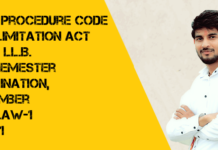Write short notes on the theories of liability.
Ans. There are two theories of liabilities: —
(1) The theory of Remedial Liability; and
(2) The theory of Penal Liability.
1. Theory of Remedial Liability–The sole condition of the exist-ence of remedial liability is existence of a legal duly binding upon the defendant. These are as under:
(i) Duties of imperfect obligation.—Such as those attached to a time-barred debt, or a debt due from the Crown which cannot be enforced at all;
(ii) Duties, which from their nature cannot be specifically enforced.—In certain cases, the nature of the duty or the corresponding right is such that it cannot be specifically enforced. For example, every one has a right to reputation and, therefore, there is a corresponding duty imposed on others not to violate such right. But if at, a libel is committed, the specific enforcement of corresponding duty of the defendant (i.e. person who has committed libel) is not possible. In other words, once a mischief has been done. it cannot be undone. In such cases, damages are perhaps the only adequate remedy.
(iii) Where specific enforcement of the duty is inadvisable.—In some cases specific enforcement is inadvisable e.g., in breach of the promise for marriage.
2. The Theory of Penal Liability Under Penal Liability there are to be considered :
(i) the `conditions’of penal liability;
(ii) the ‘incidence’ of penal liability; and
(iii) the `measures’of penal liability
(1) Conditions of penal liability.—The general conditions of penal liability are well indicated by the maxim, ‘Actits nonfacit ream nisi mens sit rea’ (the fact alone does not amount to guilt, it must be accompanied by a guilty mind), hence two conditions must be fulfilled before penal liability may be imposed—(a) material condition, and (b) formal condition.
The ‘material condition’ is the doing of some act by the person liable, and the ‘formal condition’ is the `mens rea’ or guilty mind with which the act is done. The two conditions must co-exist to make a person penally liable.
(ii) Incidence of liability.—From conditions we nowpass to its incidence. Normally and naturally the person who commits a wrong is liable for it. Yet both ancient and modern law admits instances of vicarious liability in which one man is held answerable for the act of another, masters are responsible for the acts of their servants done in course of their employment. In certain cases of civil liability damages can be recovered from the disposable estate of the deceased wrongdoer.
(iii) Measures of liability.—In criminal cases, the “motive” of the offence, the ‘magnitude’ of the offence and the ‘character’ of the offender are taken into account in fixing the punishment. In civil cases of penal redress, only the magnitude of the wrongful act or the amount of the loss inflicted by it is taken into consideration.




















